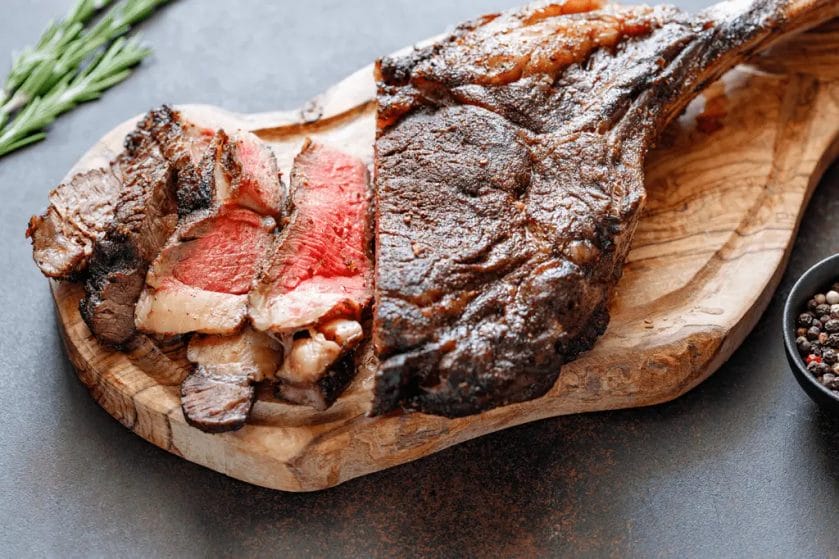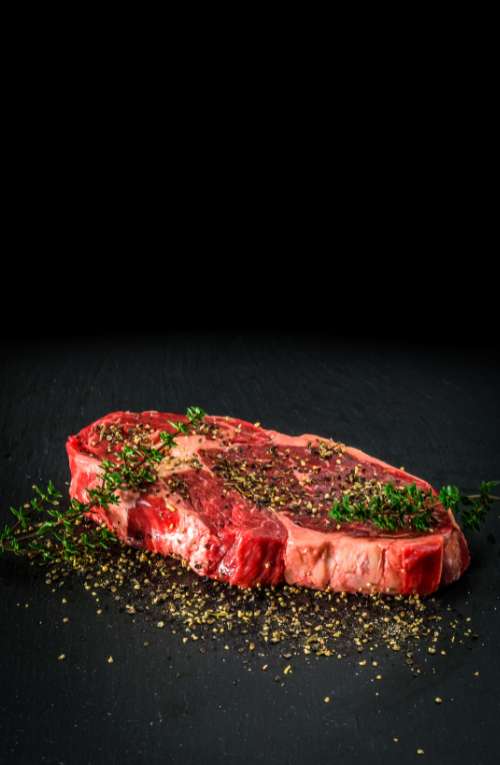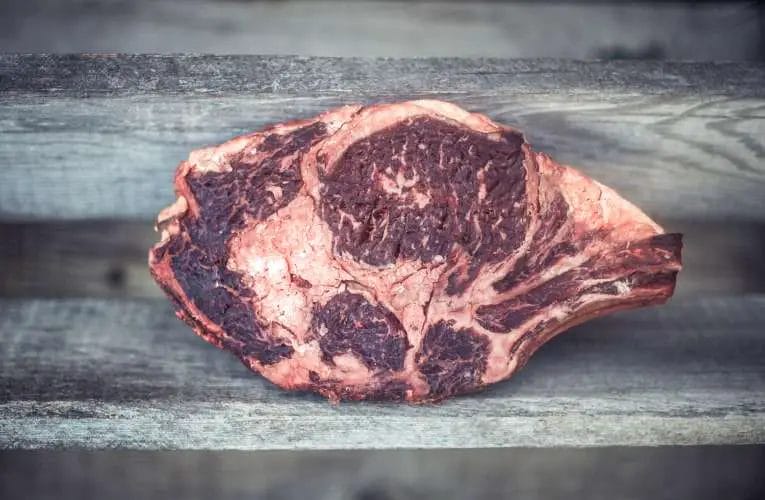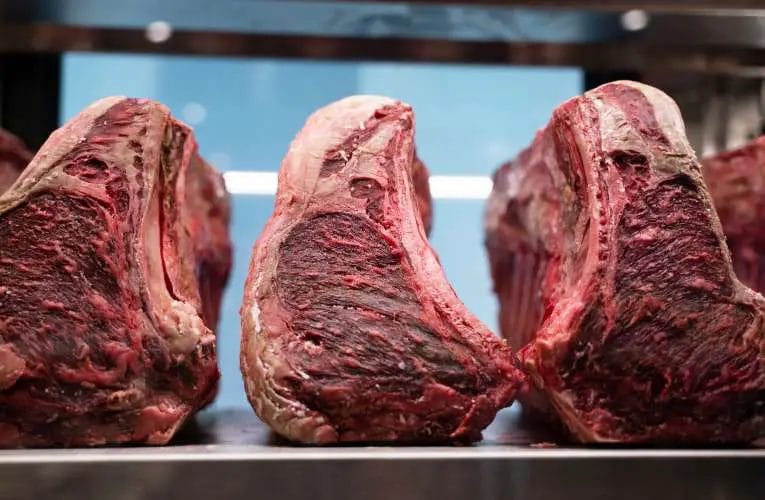Preparing dry-aged steak is a culinary experience like no other. This highly sought-after technique involves aging the steak in a controlled environment to enhance its flavor and tenderness.
Dry-aging allows natural enzymes to break down the muscle fibers, resulting in a rich, complex taste and buttery texture. The process entails carefully monitoring temperature and humidity levels to prevent spoilage while the steak develops its unique flavor profile.
Ready to indulge in a succulent dry-aged steak that melts in your mouth? Read on to discover the step-by-step preparation method.

Benefits of Dry Aging: Exploring the Flavors and Tenderness
Dry aging is a process that involves hanging beef carcasses or primal cuts in a controlled environment for a specific period of time. This traditional method has been used for centuries to enhance the flavor and tenderness of meat.
In this section, we will delve into the various benefits of dry aging and how it can elevate your culinary experience.
1. Intensified Flavor
One of the primary advantages of dry aging is the intensification of flavor. As the meat ages, the enzymes in the meat break down the muscle tissues and connective fibers, resulting in a more concentrated flavor.
The slow, controlled process allows the beef to develop complex and robust flavors that are unique to dry-aged meat.
During the aging period, moisture is evaporated from the meat, further enhancing the meat’s flavor. This concentration of flavors creates a rich and savory taste that cannot be replicated in conventionally aged or fresh meat.
2. Increased Tenderness
Dry aging also significantly improves the tenderness of the meat. As the connective tissues break down, the meat becomes more tender, making it easier to chew and enjoy.
The enzymatic action during the aging process helps to tenderize the meat, resulting in a melt-in-your-mouth texture that is highly prized by meat enthusiasts.
The transformation of tough, chewy cuts into tender, succulent meat is a result of the natural enzymatic processes that occur during dry aging. This makes it a preferred method for aging beef cuts that are traditionally tougher, such as ribeye or striploin.
3. Enhanced Texture
In addition to increased tenderness, dry aging also enhances the texture of the meat. The aging process allows the meat to develop a firmer texture, giving it a satisfying bite.
The controlled evaporation of moisture helps to concentrate the meat’s natural flavors while simultaneously improving the overall mouthfeel.
The unique texture achieved through dry aging gives the meat a more substantial and robust bite, elevating the eating experience to new heights.
4. Flavor Complexity
Dry aging imparts a depth of flavor and complexity to the meat that cannot be achieved through other methods. The slow breakdown of proteins and fats during the aging process creates a myriad of flavor compounds that contribute to the overall taste profile of the meat.
Various factors, such as temperature and humidity control during the aging process, can influence the flavor complexity. Skilled butchers and chefs often experiment with different aging techniques to achieve specific flavor profiles, resulting in a wide range of options for meat connoisseurs.
5. Customization and Personalization
Dry aging allows for customization and personalization, as the aging process can be tailored to suit individual preferences. Different cuts of beef, aging durations, and aging conditions can all influence the final flavor and tenderness of the meat.
Some individuals prefer a shorter aging period for a milder flavor, while others opt for a longer aging duration for a more pronounced taste. The ability to tailor the dry aging process makes it a versatile technique that can accommodate a variety of palates and culinary preferences.

Selecting the Right Cut: Finding the Perfect Choice for Dry Aging
When it comes to dry aging beef, selecting the right cut of meat is crucial. The cut you choose will greatly affect the final flavor and texture of the dry-aged steak. In this section, we will explore the factors you should consider when selecting the perfect cut for dry aging.
1. Marbling
One of the most important factors to consider when choosing a cut for dry aging is the amount of marbling. Marbling refers to the intramuscular fat that is present in the meat. It plays a significant role in enhancing the flavor and tenderness of the steak.
Cuts with a higher marbling score are generally preferred for dry aging, as the fat helps to keep the meat moist and tender during the aging process.
2. Thickness
The thickness of the cut is another important consideration. Thicker cuts of meat are ideal for dry aging as they allow for better moisture retention and flavor development.
Thinner cuts may dry out too quickly during the aging process and result in a less tender and flavorful steak. It is recommended to choose cuts that are at least 1.5 inches thick for optimal results.
3. Bone-in vs. Boneless
Deciding whether to choose a bone-in or boneless cut is a matter of personal preference. Bone-in cuts tend to have more flavor due to the presence of the bone marrow, which adds richness to the meat.
On the other hand, boneless cuts are generally easier to handle and carve. Consider your cooking style and preferences when making this decision.
4. Quality Grade
The quality grade of the meat is another important factor to consider when selecting a cut for dry aging. The grading system, such as USDA Prime, Choice, or Select, provides an indication of the overall quality and tenderness of the meat.
Higher quality grades generally result in more tender and flavorful steaks. It is recommended to choose cuts with a higher quality grade for dry aging.
5. Cut Selection
There are several cuts of beef that are commonly used for dry aging. Some popular choices include ribeye, striploin, and sirloin. Ribeye is known for its rich marbling and intense flavor, making it a favorite among steak enthusiasts.
Striploin, also known as New York strip, offers a balanced combination of tenderness and flavor. Sirloin is another versatile cut that delivers excellent flavor when dry aged. Consider your preferences and desired flavor profile when selecting the cut.
6. Aging Time
The aging time is an essential factor to consider when dry aging beef. The longer the meat is aged, the more intense the flavor becomes. However, the aging time may vary depending on the cut and the desired taste.
For example, ribeye steaks are commonly aged for 30-45 days, while striploin may require a shorter aging period. It is important to follow recommended guidelines and consult with experts to determine the optimal aging time for the specific cut.
Dry Aging Techniques: Traditional vs. Modern Approaches
Dry aging is a process that enhances the flavor and tenderness of meat, particularly beef. This technique involves hanging the meat in a controlled environment for an extended period, allowing natural enzymes to break down the muscle fibers and develop a unique taste.
However, there are different approaches to dry aging, with traditional and modern methods being the most common. In this section, we will explore the differences between these two techniques.
Traditional Dry Aging
Traditional dry aging is the method that has been used for centuries to achieve the desired flavor and texture in meat.
This process involves hanging whole beef carcasses or large cuts of meat in a temperature and humidity-controlled environment for several weeks. The meat is left uncovered, allowing moisture to evaporate and concentrate the flavors.
One key aspect of traditional dry aging is the use of air circulation. The meat is typically hung on hooks or racks, allowing air to circulate around all sides of the meat.
This circulation helps to remove moisture and promote the development of flavors. Additionally, traditional dry aging requires specific temperature and humidity levels to ensure optimal results.
Another characteristic of traditional dry aging is the formation of a dry, protective crust on the outer layer of the meat. This crust acts as a barrier, preventing spoilage and protecting the meat from external contaminants.
However, it is important to note that this crust needs to be trimmed off before cooking or serving the meat.
Modern Dry Aging
In recent years, modern dry aging techniques have emerged, offering alternative methods to achieve similar results. One popular modern approach is the use of dry aging bags or membranes. These specialized bags allow for dry aging in a more controlled and hygienic manner.
With the use of dry aging bags, the meat is placed inside the bag, which is designed to allow moisture to escape while preventing any external elements from entering. This method eliminates the need for trimming the outer crust and reduces the risk of contamination.
Modern dry aging techniques also offer more flexibility in terms of time and space. While traditional dry aging requires a dedicated aging room or chamber, modern methods allow for dry aging in regular refrigerators or coolers.
This makes it more accessible for home cooks or smaller establishments to experiment with dry aging.
Additionally, modern dry aging techniques often result in a shorter aging period compared to traditional methods. This is due to the more controlled environment and the absence of the protective crust, which can lead to a faster flavor development.
Choosing the Right Technique
When deciding between traditional and modern dry aging techniques, there are several factors to consider. Traditional dry aging is often preferred by those who value the traditional and artisanal aspects of the process. It requires more time, space, and attention to detail.
On the other hand, modern dry aging techniques offer convenience and lower risk of contamination. It is a suitable option for those who want to try dry aging at home or in smaller establishments. However, some purists may argue that the flavor development is not as pronounced as in traditional dry aging.

Creating the Ideal Aging Environment: Temperature, Humidity, and Airflow
Aging is a crucial process in the development of certain products, such as wine, cheese, and cigars. It involves allowing these products to mature and develop their desired flavors and characteristics over time.
To achieve optimal aging results, it is important to create the ideal environment, which includes controlling temperature, humidity, and airflow. In this section, we will explore the significance of each of these factors and how to maintain them for successful aging.
1. Temperature
Temperature plays a vital role in the aging process. It affects the chemical reactions that occur within the product, influencing its flavor, texture, and overall quality. Different products have specific temperature requirements for aging. Here are some general guidelines:
- Wine: Most wines require a temperature range of 55°F to 65°F (12°C to 18°C) for aging. Fluctuations in temperature can negatively impact the aging process and result in off-flavors.
- Cheese: Cheese aging typically requires temperatures between 50°F and 60°F (10°C to 15.5°C). This temperature range allows for the development of complex flavors and textures.
- Cigars: Cigars should be stored at a temperature of around 70°F (21°C) with a maximum tolerance of 75°F (24°C). Higher temperatures can cause the tobacco to dry out and lose its desired characteristics.
To maintain the desired temperature, it is advisable to use specialized equipment such as temperature-controlled aging rooms or cellars. These spaces are designed to provide consistent temperature levels throughout the aging process.
2. Humidity
Humidity is another critical factor in creating the ideal aging environment. It affects the moisture content of the product and influences its texture, aroma, and flavor development. Here are some humidity guidelines for different products:
- Wine: Wine aging requires a humidity level of around 60% to 80%. This range prevents the corks from drying out and maintains the integrity of the wine.
- Cheese: Cheese aging typically requires a humidity level of 80% to 90%. Higher humidity helps prevent the cheese from drying out and promotes the growth of beneficial molds.
- Cigars: Cigar aging requires a humidity level of around 70% to 72%. This humidity range ensures that the cigars remain moist and supple, allowing the flavors to develop harmoniously.
To control humidity, humidifiers and dehumidifiers can be used in conjunction with temperature-controlled environments. These devices help maintain the desired humidity level and prevent fluctuations that could negatively impact the aging process.
3. Airflow
Adequate airflow is essential for proper aging. It helps prevent the buildup of stagnant air, regulates temperature and humidity distribution, and minimizes the risk of mold or bacterial growth. Here are some considerations for airflow:
- Wine: Wine should be stored in a cellar or aging room with good ventilation. This allows for the exchange of air, preventing musty odors and maintaining consistent conditions.
- Cheese: Cheese aging requires proper airflow to prevent the growth of unwanted molds. Cheese caves or aging rooms with controlled ventilation systems ensure optimal airflow for the aging process.
- Cigars: Cigar humidors should be equipped with air circulation systems, such as fans or vents, to maintain a constant flow of fresh air. This prevents stale or musty odors and helps preserve the quality of the cigars.
It is important to note that each product may have specific requirements for temperature, humidity, and airflow. Consulting experts or following product-specific guidelines is crucial to ensure the best aging results.

Mastering the Dry Aging Process: Tips and Tricks for Tender, Flavorful Steaks
Dry aging is a process that allows the natural enzymes in meat to break down the muscle fibers, resulting in tender and flavorful steaks. It’s a delicate process that requires time, patience, and attention to detail.
In this section, we will explore the steps involved in mastering the dry aging process, along with some valuable tips and tricks to ensure the best results.
1. Choosing the Right Cut of Meat
When it comes to dry aging, not all cuts of meat are created equal. It’s important to select the right cut that has enough marbling and fat content to enhance the flavor and texture during the aging process.
The most commonly dry-aged cuts include ribeye, strip loin, and sirloin. These cuts have a good balance of fat and muscle, which yields tender and juicy steaks.
2. Preparing the Meat for Dry Aging
Before you begin the dry aging process, ensure that the meat is properly prepared. Trim off any excess fat or silver skin from the surface of the meat.
This will prevent any off-flavors from developing during the aging process. It’s also advisable to use a dry aging bag or mat to protect the meat from external moisture and bacteria while allowing it to breathe.
3. Creating the Ideal Aging Environment
The conditions in which the meat ages play a crucial role in the final outcome. Ideally, the temperature should be around 34-38°F (1-3°C) and the humidity levels should be between 65-75%.
This helps to promote the growth of beneficial bacteria and enzymes while inhibiting the growth of harmful bacteria. Investing in a dedicated refrigerator or dry aging cabinet can provide precise control over these environmental factors.
4. Time Matters: Aging Duration
Patience is key when it comes to dry aging. The duration of the aging process depends on personal preference and the desired level of flavor and tenderness.
Typically, dry aging can range from 14 to 60 days. Longer aging periods intensify the flavors and result in a more tender texture. It’s important to regularly check the meat during the aging process to ensure it doesn’t spoil or develop any off-flavors.
5. Proper Air Circulation and Turning
During the dry aging process, proper air circulation is crucial to prevent the growth of harmful bacteria. Ensure that the meat is placed on a rack or suspended to allow air to flow around all sides.
Additionally, turning the meat every few days helps to distribute the moisture and enzymes evenly, resulting in a more uniform aging process.
6. Trimming and Butchering
Once the desired aging period is complete, it’s time to trim and butcher the aged meat into individual steaks. Remove the outer dry layer to reveal the beautifully aged meat underneath.
Trim off any excess fat or darkened portions to achieve the desired presentation and flavor. Take care to use proper butchering techniques to ensure clean cuts and even portions.
7. Cooking and Enjoying the Perfect Dry Aged Steak
Now that your dry aged steaks are ready, it’s time to cook and savor the results of your hard work.
Dry aged steaks are best cooked using high-heat methods such as grilling or pan-searing to achieve a crusty exterior while maintaining a juicy and tender interior. Keep in mind that dry aged steaks cook faster than regular steaks, so it’s important to monitor the cooking process closely to avoid overcooking.

FAQs
Q: How to prepare dry-aged steak?
To prepare dry-aged steak, start by removing it from the packaging and patting it dry with paper towels. Season the steak generously with salt and any other preferred spices.
Place the steak on a wire rack in the refrigerator, uncovered, for 3-7 days to allow it to dry age. Once aged, heat a skillet or grill to high heat and cook the steak for a few minutes on each side, depending on desired doneness. Rest the steak for a few minutes before slicing and serving.
Conclusion
In conclusion, mastering the art of preparing dry-aged steak requires time, patience, and precision. By following the right steps, you can elevate the flavor and tenderness of your steak to a whole new level.
The process of dry aging steak involves allowing the meat to rest in a controlled environment, where natural enzymes break down the muscle fibers, resulting in a more intense flavor and buttery texture.
Remember to source high-quality, well-marbled cuts of beef and invest in a dedicated dry aging fridge or use the dry-aging method in your regular refrigerator.
Lastly, don’t forget to trim off any dried exterior before cooking and enjoy the delicious reward of your efforts!

